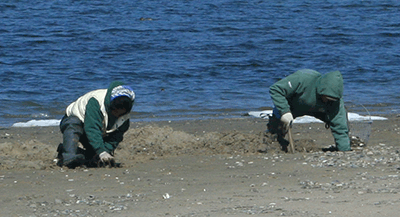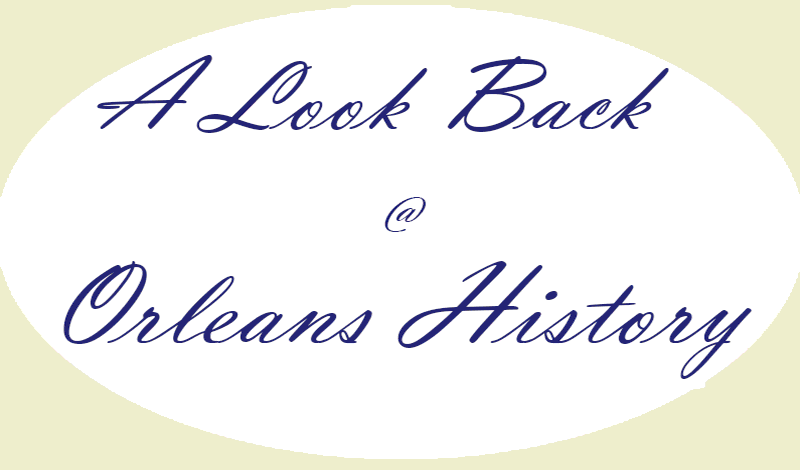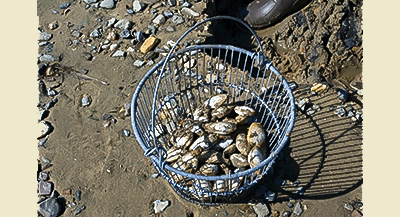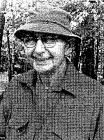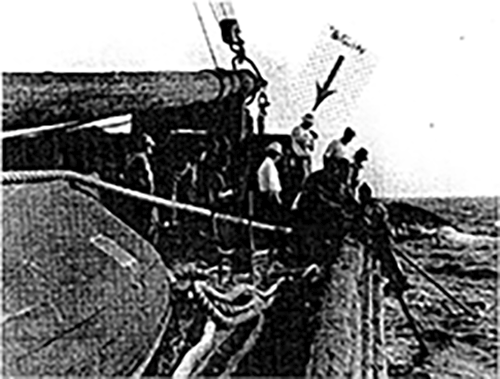SUBMARINE ATTACK OFF CAPE COD, July 1918
(A recollection in the Kinfolk Fall/Winter edition)
Editor's note: Warren Rich and Bob Park had an interesting talk this Spring with RFA Life Members Richard F. Rich and his son Martin D. Rich. This article is from the eye witness account of Richard, shown right, photographed at the time of the interview.
It was 1918, and I knew there was a war going on in Europe. -But as a boy of 11, summering on Cape Cod, the war didn't mean much. In retrospect it has always seemed unusual to go out of the house on a beautiful Sunday morning, take a motor boat ride to a lovely sandy beach, and watch a German submarine sink three barges by gunfire.
I had spent 10 summers on Cape Cod with my parents who owned a house on Weeset Point overlooking Nauset Harbor, in Orleans, Massachusetts.
In those days the Cape was rural; the bakery wagon, the meat wagon, and the ice wagon arrived at the house on a varied schedule during the week. Looking forward to, and the arrival of, these wagons (especially the bakery wagon) was most enjoyable. I even knew the names of the horses.
The Sunday paper usually arrived by train at 10 in the morning, and that too was a big event for me. There was a boat ride of three miles through the Town Cove, then a short walk to the village, seeing the people, the funny papers, and generally ice cream. Usually we went in my father's dory, powered by a single cylinder Gray engine. However, on this day, Mr. E.D. Sawyer of the E.D. Sawyer Lumber Company of Somerville, who was a friend of my father, had invited our family to go in his boat.
The Sawyer home was on Nauset Harbor, about a quarter of a mile from our house, and very visible from our porch. I could see when the Sawyer's boat left their mooring, and with a coming tide they were quickly at our landing.
Then gunfire was heard from out the harbor way.
I heard Mr. Sawyer say, "Let's go down to the beach and see what's going on." As my mother was getting in the boat, I was sent up to the house to get the field glasses, and we were off to the sound of the shooting.
By the time we arrived at North Beach, which is the north side of Nauset Harbor, the shelling had been quite constant. About every two minutes we heard an explosion. Looking out over the ocean, it was apparent that a German sub was attacking a towboat and three barges. There was smoke coming from the towboat.
I believe fog is not unique to any body of water; however, at times the Atlantic Ocean off Cape Cod keeps a fog bank laying offshore, actually on the horizon, and this was the case on July 21, 1918. This fog bank acted as a backdrop; although we were two or so miles away the scene was very visible.
The submarine looked like a log on the water; we could keep track of it by the flash of its gun or guns. It was noticeable that the sub stayed outside the vessels so that at all times the flash of the guns could be seen. Apparently the sub, with an enemy that could not shoot back, slowly went by the vessels, shooting at each as it went by. As we watched, one barge went out of sight. Then someone noticed a small boat (later found to be a dory) landing on the beach below Nauset Bluff.
At one point a seaplane was seen coming from the south. I remember looking at it through the field glasses and noting that it was extremely high. It quickly turned and went back.
The channel of Nauset Harbor in 1918 was very close to Nauset Bluff which formed the south side of the harbor. It was occupied by many summer cottages and due to its height was a very popular place for the townspeople to see the surf in stormy weather. The north side of the harbor, where we were located during this episode, was a wide sandy beach, with 30 foot dunes partially covered with beach grass. In those days this beach extended some distance beyond the South Beach to the east, so that in our position we could look down the coast, past the South Beach. I have often said that I was closer to the sub than most people watching the event.
The news of the submarine spread like wildfire. As we looked back towards the bluff it was literally covered with people. By this time two other small boats had come ashore under the bluff,so we went over there. I remember seeing a middle-aged man with half his face shaved; he had been shaving when the first shell hit. Another man had hurt his hands, as they were quite bloody.
As quickly as it had started the shelling stopped. The sub had fired around 100 or so shells, had sunk three barges, and left a towboat burning. That night I could sit up in bed and from my bedroom window watch the towboat burning, which it continued to do most of the night.
During the next few days my father (Richard Rich) went out to the towboat with a local lobster fisherman and a Boston Globe reporter. He learned that the barges sank in about 100 feet of water, landing one on top of another. The top barge was slightly out of the water. Because of the hazard to shipping they were later blown up.
So I ended with a few pictures of the aftermath of the event, and a piece of shrapnel which my father pried out of the towboat.
When I reflect on this event, as I have many times, I have come to the conclusion that patriotism was at its zenith in 1918. In my life span of 89 odd years patriotism seems to have gone downhill, and I regret it.
--Richard Rich, Orleans, Cape Cod.
Crews working on clearing the area after the "battle". Arrows point to Richard Rich, Sr.
APPENDIX to SUBMARINE ATTACK OFF CAPE COD July 1918 by Warren A. Rich, 1996
Editor's Note: Talking with Richard Rich, a living, first-hand witness of this submarine attack, encouraged Warren
Rich to search for other published information. Below are his gleanings.
Weather - Sunny, with a cloud bank lying offshore.
Location - North 41-47-56 Latitude West 69-52-36 Longitude.
Aggressor - German submarine U 156, 213 feet long, 2 deck guns. From Kiel, Germany 15 June 1918, Kapitan-Lieutenant Richard Feldt Commander Kapitan, Lieutenant Von Oldenberg Skipper.
Victims - Tugboat "Perth Amboy", Skipper Captain Joe Tapley
Barge 1 "Lansford", Captain Charles Ainsleigh, wood construction, cargo, granite blocks.
Barge 2 # 766 Captain Harry Rabe wood
Barge 3 # 703 Captain Peter B. Peterson wood
Barge 4 # 740 Captain Joseph Jerry wood
All of the above vessels owned by Lehigh Valley Rail Road.
Navigation - The barges proved to be hazardous to navigation. Richard Rich Sr. was on the boats that checked the "Perth Amboy" and the barges, and was there when explosives were used to clear the area for navigation.
Perth Amboy - The tugboat "Perth Amboy" was towed to Vineyard Haven by the rescue tug "Lehigh" and then to a New York shipyard. "Perth Amboy" was rebuilt and worked for years. During World War II she was sent to England on Lend Lease; there she helped evacuate British soldiers from Dunkirk in the English Channel, June 1940, over three thousand miles away from Eastham, Orleans, Cape Cod, U.S.A.
Revenge - Submarine U 156 was sunk when she hit a mine on her way home near her home port Kiel, Germany.
